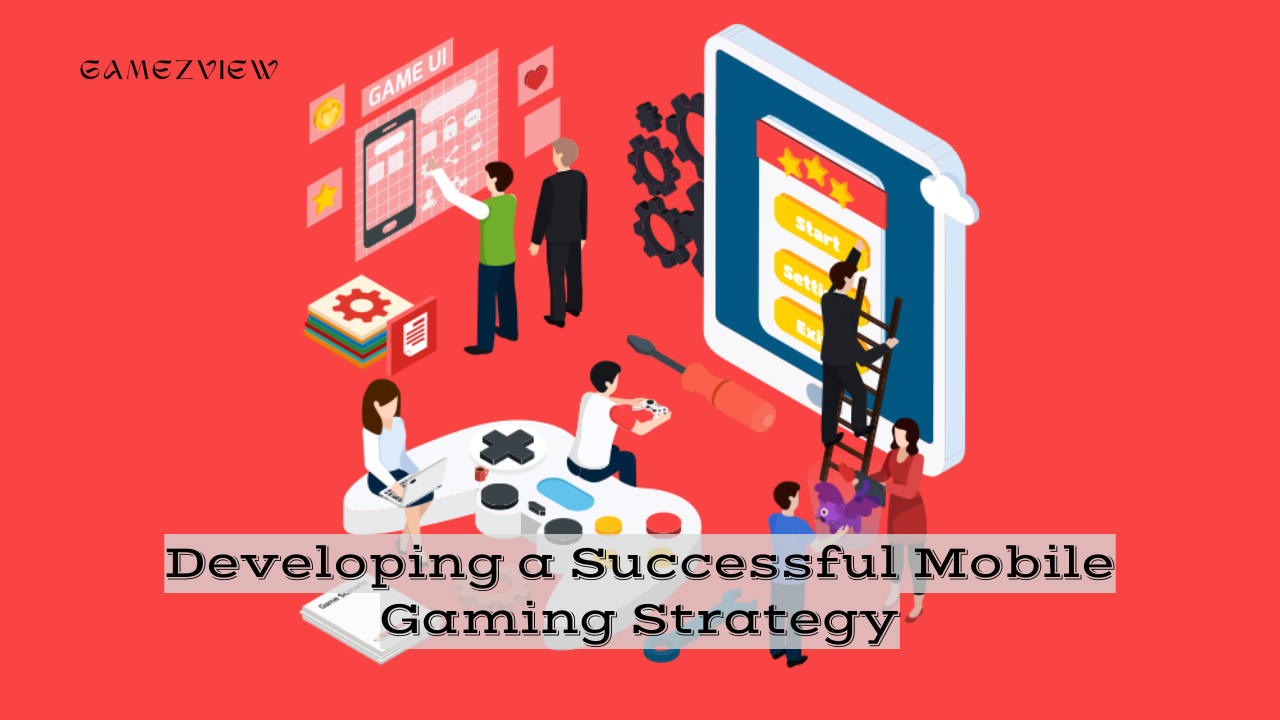The mobile gaming industry has experienced explosive growth over the past decade, becoming a multi-billion-dollar industry that attracts millions of players worldwide. With the rise of smartphones and tablets, mobile gaming has become accessible to a broader audience, creating opportunities for developers to create games that reach millions of players. However, in this highly competitive market, developing a successful mobile gaming strategy requires more than just a good idea. It involves careful planning, a deep understanding of the market, and the ability to adapt to changing trends.
In this guide, we will explore the key elements of a successful mobile gaming strategy, from understanding your target audience to monetization and user retention. Whether you are a seasoned developer or a newcomer to the industry, these insights will help you create a game that not only captures the attention of players but also sustains long-term success.

1. Understanding the Mobile Gaming Market
Before diving into game development, it is crucial to understand the mobile gaming market. This involves analyzing market trends, understanding the competition, and identifying potential opportunities.
a. Market Research
Market research is the foundation of any successful mobile gaming strategy. It involves studying the current market landscape, identifying popular game genres, and understanding what players are looking for in a mobile game. This research can be conducted through various methods, including surveys, focus groups, and analyzing data from app stores.
b. Analyzing Competitors
Understanding your competition is essential for developing a unique game that stands out in the market. Analyze the top games in your chosen genre, identify their strengths and weaknesses, and learn from their successes and failures. This will help you create a game that offers something new and exciting to players.
c. Identifying Opportunities
The mobile gaming market is constantly evolving, with new trends emerging regularly. Identifying these trends and opportunities can give you a competitive edge. For example, the rise of augmented reality (AR) and virtual reality (VR) in mobile gaming presents new possibilities for immersive gameplay experiences. By staying ahead of the curve and incorporating these trends into your game, you can attract a wider audience.
Future Predictions for the Mobile Gaming Market: What Lies Ahead
2. Defining Your Target Audience
One of the most critical aspects of developing a successful mobile gaming strategy is understanding your target audience. Knowing who your players are and what they want will guide every aspect of your game’s development, from design to marketing.
a. Demographics
Identify the demographic characteristics of your target audience, such as age, gender, and location. This information will help you create a game that appeals to your intended audience. For example, if your target audience is primarily young adults, you may want to focus on fast-paced action games or social multiplayer experiences.
b. Psychographics
Beyond demographics, psychographics provides insights into the attitudes, interests, and behaviours of your target audience. Understanding what motivates your players, what types of games they enjoy, and how they spend their time can help you create a game that resonates with them on a deeper level.
c. Player Personas
Creating player personas is a valuable exercise in defining your target audience. These personas represent different segments of your audience, each with its own preferences and gaming habits. By developing detailed personas, you can tailor your game to meet the needs of each segment, increasing the likelihood of success.
3. Designing an Engaging Gameplay Experience
The gameplay experience is the heart of any mobile game. It’s what keeps players coming back and what ultimately determines the success of your game. Designing an engaging gameplay experience involves creating a balance between challenge and reward, ensuring that the game is both fun and accessible.
a. Core Gameplay Mechanics
The core gameplay mechanics are the fundamental actions that players will perform throughout the game. These mechanics should be intuitive and easy to learn but offer depth and complexity that keep players engaged over time. Whether it’s solving puzzles, battling enemies, or building empires, the core mechanics should align with the preferences of your target audience.
b. User Interface (UI) and User Experience (UX) Design
A well-designed user interface (UI) and user experience (UX) are crucial for making your game accessible and enjoyable. The UI should be intuitive, with clear navigation and responsive controls. The UX should guide players smoothly through the game, providing feedback and rewards that encourage continued play. Consider conducting usability testing to identify any potential pain points in the player experience and make necessary adjustments.
c. Level Design and Progression
Level design and progression play a significant role in maintaining player engagement. Levels should gradually increase in difficulty, providing a sense of accomplishment as players progress. Incorporate a variety of challenges and objectives to keep the gameplay fresh and exciting. Additionally, consider implementing a progression system that rewards players for their achievements, such as unlocking new levels, characters, or abilities.
d. Graphics and Sound Design
High-quality graphics and sound design enhance the overall gaming experience and contribute to the game’s immersion. The visual style should align with the theme and tone of the game, whether it’s realistic, cartoonish, or minimalist. Sound effects and music should complement the gameplay, providing audio cues that enhance the experience. Invest in professional design and sound assets to ensure your game looks and sounds polished.

4. Monetization Strategies
Monetization is a critical aspect of any mobile gaming strategy. Without a sustainable revenue model, even the most popular games can struggle to maintain long-term success. There are several monetization strategies to consider, each with its advantages and challenges.
a. In-App Purchases (IAP)
In-app purchases (IAP) are one of the most common monetization strategies in mobile gaming. Players can purchase virtual goods, such as cosmetic items, power-ups, or currency, to enhance their gameplay experience. To succeed with IAP, it’s essential to strike a balance between offering valuable items and maintaining a fair gameplay experience. Avoid creating a “pay-to-win” scenario, where players who spend money have an unfair advantage over those who don’t.
b. Advertising
Advertising is another popular monetization strategy. In-game ads can take various forms, including banner ads, interstitial ads, and rewarded video ads. Rewarded video ads, where players receive in-game rewards for watching an ad, have proven to be particularly effective. However, it’s important to ensure that ads do not disrupt the gameplay experience or frustrate players.
c. Subscription Models
Subscription models are becoming increasingly popular in the mobile gaming industry. Players pay a recurring fee to access premium content, exclusive features, or an ad-free experience. Subscription models can provide a steady stream of revenue, but they require a consistent flow of new content to keep players engaged and willing to pay.
d. Paid Games
While free-to-play games dominate the mobile gaming market, paid games still have a place. Charging an upfront fee for your game can be a viable strategy if your game offers a unique or high-quality experience that justifies the cost. However, this model requires a strong marketing campaign to convince players to make the purchase.
5. User Acquisition and Marketing
A successful mobile gaming strategy doesn’t end with the development of the game. Effective user acquisition and marketing are essential for getting your game in front of players and driving downloads.
a. App Store Optimization (ASO)
App Store Optimization (ASO) is the process of optimizing your game’s listing on app stores to improve its visibility and attract more downloads. This involves optimizing your game’s title, description, keywords, and visuals (such as the icons and screenshots) to make it more appealing to potential players. Regularly update your ASO strategy based on analytics and user feedback to improve your game’s ranking.
b. Social Media Marketing
Social media platforms are powerful tools for promoting your mobile game. Create engaging content that showcases your game’s features, gameplay, and updates. Leverage platforms like Facebook, Instagram, Twitter, and TikTok to reach your target audience and build a community of players. Consider running targeted ads on these platforms to drive user acquisition.
c. Influencer Partnerships
Partnering with influencers can be an effective way to promote your mobile game to a wider audience. Identify influencers who have a following that aligns with your target audience and collaborate with them to create content that showcases your game. Influencer partnerships can help build credibility and generate buzz around your game, leading to increased downloads.
d. Community Building
Building a community around your game is essential for long-term success. Engage with your players through social media, forums, and in-game chat features. Listen to their feedback, address their concerns, and involve them in the development process by sharing updates and sneak peeks. A strong community can help spread the word about your game and foster player loyalty.
6. User Retention and Engagement
Attracting players to your game is only the first step. Keeping them engaged and retaining them over the long term is equally important. High user retention leads to a loyal player base, which is crucial for the success of your mobile game.
a. Onboarding Process
The onboarding process is the first impression players have of your game. A smooth and intuitive onboarding process is essential for retaining new players. Introduce the core gameplay mechanics gradually and provide clear instructions to help players get started. Avoid overwhelming players with too much information at once and allow them to explore the game at their own pace.
b. Regular Updates and Content
Regular updates and new content are key to keeping players engaged. Introduce new levels, characters, events, and challenges to keep the gameplay fresh and exciting. Communicate these updates to your players through in-game notifications, social media, and email newsletters. Players are more likely to stick with a game that offers new content regularly.
c. In-Game Events and Rewards
In-game events and rewards are effective tools for boosting player engagement. Host special events, such as limited-time challenges or tournaments, that offer exclusive rewards. These events create a sense of urgency and encourage players to return to the game regularly. Additionally, implement a daily rewards system that incentivizes players to log in each day.
d. Player Feedback and Iteration
Listening to player feedback is crucial for improving your game and maintaining player satisfaction. Encourage players to share their thoughts through in-game surveys, social media, or app store reviews. Use this feedback to make informed decisions about updates and improvements. Regularly iterate on your game based on player feedback to ensure it continues to meet their expectations.

7. Data Analytics and Performance Tracking
Data analytics play a vital role in the success of a mobile gaming strategy. By tracking key performance indicators (KPIs) and analyzing player behaviour, you can make data-driven decisions that improve your game’s performance and user experience.
a. Key Performance Indicators (KPIs)
Identify and track key performance indicators (KPIs) that are relevant to your game’s success. Common KPIs in mobile gaming include daily active users (DAU), retention rate, average revenue per user (ARPU), and lifetime value (LTV). Monitoring these metrics will help you understand how well your game is performing and identify areas for improvement.
b. A/B Testing
A/B testing is a valuable tool for optimizing various aspects of your game. Test different versions of features, UI elements, or monetization strategies to determine which performs better. For example, you can test different ad placements or pricing models to see which generates the most revenue without negatively impacting the player experience. Use the results of A/B testing to make informed decisions about your game’s design and strategy.
c. Player Behavior Analysis
Analyzing player behaviour provides insights into how players interact with your game. Use analytics tools to track player actions, such as level completion rates, in-app purchases, and time spent in the game. This data can help you identify pain points in the player experience and make adjustments to improve engagement and retention.
d. Real-Time Analytics
Real-time analytics allow you to monitor your game’s performance as it happens. This is particularly useful during the launch phase or when introducing new features. Real-time data can help you quickly identify and address any issues, such as bugs or server performance problems before they impact a large number of players.
Differences Between Mobile Gaming and Traditional Gaming: A Comprehensive Analysis
8. Legal Considerations and Compliance
When developing a mobile game, it’s important to consider the legal aspects of game development and ensure compliance with relevant regulations. Failing to address these considerations can lead to legal issues and damage your game’s reputation.
a. Intellectual Property (IP) Protection
Protecting your intellectual property (IP) is crucial in the mobile gaming industry. This includes trademarks, copyrights, and patents related to your game’s title, characters, artwork, and code. Ensure that you have the necessary legal protections in place to prevent others from copying or infringing on your game.
b. Data Privacy and Security
Data privacy and security are critical in mobile gaming, especially if your game collects personal information from players. Ensure compliance with data protection regulations, such as the General Data Protection Regulation (GDPR) in the European Union or the California Consumer Privacy Act (CCPA) in the United States. Implement robust security measures to protect player data from breaches and unauthorized access.
c. Age Ratings and Content Compliance
Mobile games must comply with age rating systems, such as the Entertainment Software Rating Board (ESRB) or the Pan European Game Information (PEGI) system. Ensure that your game’s content is appropriate for its intended audience and that it adheres to the guidelines of the relevant rating system. Misrepresenting your game’s content can lead to penalties and harm your game’s reputation.
9. Preparing for Launch
Launching your mobile game is a critical step in your strategy. A successful launch sets the tone for your game’s long-term success and can generate significant buzz and downloads.
a. Soft Launch
A soft launch involves releasing your game in a limited market, such as a specific country or region, before a global launch. This allows you to test your game’s performance, gather feedback, and make any necessary adjustments before the full release. Use the soft launch period to optimize your game’s performance, address any issues, and refine your marketing strategy.
b. Pre-Launch Marketing
Building anticipation for your game before launch is crucial for generating interest and driving downloads. Create a pre-launch marketing campaign that includes teaser trailers, gameplay previews, and social media promotions. Consider offering pre-registration rewards to incentivize players to sign up for the game before its release.
c. Post-Launch Support
The work doesn’t end once your game is launched. Post-launch support is essential for maintaining player engagement and addressing any issues that arise. Monitor your game’s performance closely in the days and weeks following the launch and be prepared to release updates and bug fixes as needed. Engage with your players through social media and in-game communication to keep them informed about upcoming content and events.

10. Long-Term Strategy and Future Planning
A successful mobile game is not a one-time project but an ongoing endeavour. Developing a long-term strategy and planning for the future will help ensure your game’s continued success.
a. Expanding Content and Features
Continuously expanding your game’s content and features is essential for keeping players engaged over the long term. Plan for regular updates that introduce new levels, characters, and gameplay mechanics. Consider adding social features, such as leaderboards or multiplayer modes, to enhance the player experience and encourage community building.
b. Exploring New Platforms
As your game gains popularity, consider expanding to new platforms, such as tablets, smart TVs, or even consoles. Adapting your game for different devices can help you reach a broader audience and increase your revenue potential.
c. Sequels and Spin-Offs
If your game is successful, consider developing sequels or spin-offs that build on the original game’s success. These can introduce new storylines, characters, or gameplay mechanics while retaining the core elements that made the original game popular. Sequels and spin-offs can help you capitalize on your game’s success and create a lasting franchise.
d. Staying Adaptable
The mobile gaming industry is constantly evolving, with new technologies, trends, and player preferences emerging regularly. Staying adaptable and being willing to pivot your strategy in response to these changes is essential for long-term success. Keep a close eye on industry trends, player feedback, and competitor activity, and be prepared to adjust your game’s development and marketing strategies accordingly.
Developing a successful mobile gaming strategy requires a combination of creativity, market understanding, and adaptability. By carefully planning each stage of your game’s development, from market research to post-launch support, you can create a game that not only captures the attention of players but also sustains long-term success. Keep in mind that the mobile gaming industry is highly competitive, and staying ahead of the curve requires continuous innovation and a deep understanding of your target audience. With the right strategy in place, your mobile game can become a hit that stands the test of time.



